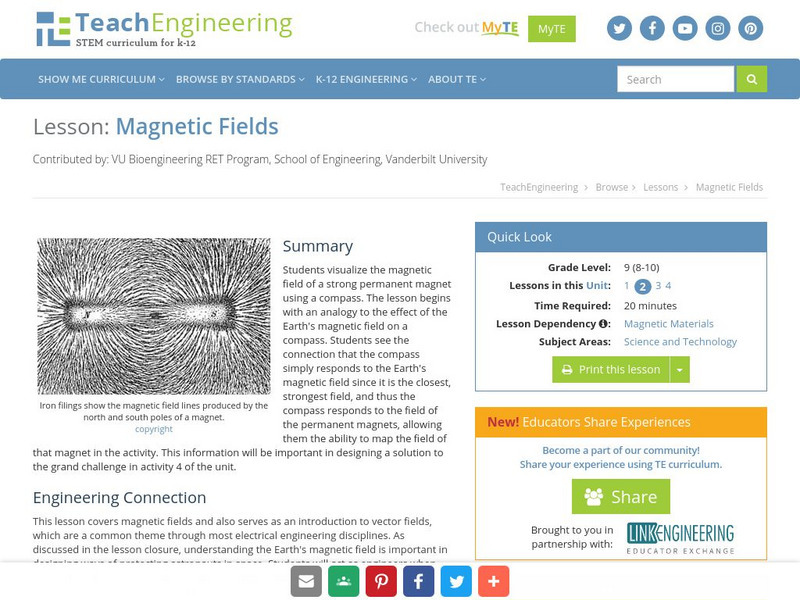Lesson Plans
Analogy of the Cell Project
Intended to supplement your existing cell function and organelle lessons, pairs work together to develop a real-world analogy for cell structures. In addition to writing paragraphs about the comparison, each group will make a short...
Curated OER
Reading Comprehension: History of the Periodic Table
Although the article that launches this lesson plan is about the history of the Periodic Table, the objective is reading comprehension. Using the eight-page informational text, learners answer five comprehension questions and craft one...
American Chemical Society
The Periodic Table and Energy-Level Models
Teach your class to think of electrons as tiny packets of energy that travel in waves. Through a short video and diagram, participants see how electrons are located around the nucleus of an atom. They then get into groups and try to...
Curated OER
Cell Analogies!
Liken a cell and its organelles to a tiny person and its organs. After gathering information on cell structures and their functions, small groups collaborate to come up with an analogy of their own. They produce a collage describing the...
Curated OER
Geologic Time Scale Analogy
Students examine geologic time to scale. In this geologic time lesson, students create a time-scale metaphor that shows some of the Earth's important events. Students present their metaphor to the class.
Curated OER
Climbing the Double Helix: DNA Lesson Plans
With the right DNA lesson plans, students can learn about the structure and function of DNA.
Kenan Fellows
What Element Would You Be?
Primo Levi wrote a collection of short stories comparing his life from Italy to Auschwitz to elements in the periodic table. Pupils read an excerpt from his book and research the characteristics of various elements. Then, they make a...
New York State Education Department
TASC Transition Curriculum: Workshop 4
Why is it important to use precise language? Participants explore this question in the fourth activity in a series of 15 on effective instruction. Perfect for all content areas, the activity promotes appropriate language choice through...
Curated OER
The Ultimate Choreography
Eighth graders research the required elements of the short programs in men's and women's figure skating. They analyze the physical requirements of each move and relate the types of muscles, bones, and joints required to perform them.
Curated OER
Cancer Research
Students participate in a class demonstration to see how many Americans are affected by cancer in their lifetime. In this public health lesson, students are placed in situations that allow them to experience how relevant cancer...
Curated OER
Mastering the Parts of a Cell
There are great lessons and tricks you can use for teaching your students about cellular organelles.
Curated OER
Cell Me What?
Students compare and contrast the characteristics of robots and cells. In this biology lesson, students examine the parts and function of cell organelles. They create a visual representation of their cell/robot analogy.
Curated OER
Circuits and Conductors
Fourth graders investigate the concepts of circuits and conductors. In this circuits and conductors lesson set, 4th graders watch demonstrations of circuits and look at images to identify whether they are complete circuits. They test...
Curated OER
Bird Beak Anatomy
Third graders participate in an activity to determine which tool will work the best to gather food. They create analogies about how the experiment relates to birds. They brainstorm about which adaptation helps or hurts the survival of an...
Curated OER
Energy Transformation
Young scholars identify different kinds of energy such as heat energy, kinetic energy, potential energy, and magnetic energy. They investigate the concept of conservation of energy.
Curated OER
Ionic bonding
Learners explore ionic bonding. They draw examples of ionic bonding and explain the activities of the electrons of the elements. Students use paper plates and candy to draw electron configurations of given atoms.
TeachEngineering
Teach Engineering: Magnetic Fields
Young scholars visualize the magnetic field of a strong permanent magnet using a compass. The activity begins with an analogy to the effect of the Earth's magnetic field on a compass. Students see the connection that the compass simply...
TeachEngineering
Teach Engineering: Energy of Motion
By taking a look at the energy of motion all around us, students learn about the types of energy and their characteristics. They first learn about the two simplest forms of mechanical energy: kinetic and potential energy, as illustrated...
TeachEngineering
Teach Engineering: Simple Machines and Modern Day Engineering Analogies
Students apply the mechanical advantages and problem-solving capabilities of six types of simple machines (wedge, wheel and axle, lever, inclined plane, screw, pulley) as they discuss modern structures in the spirit of the engineers and...


















